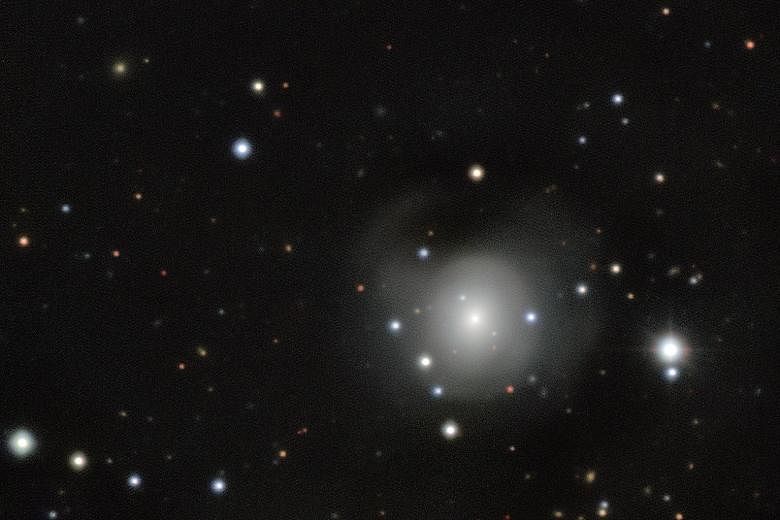As scientific claims go, this week's news of an exotic gold-producing star collision asked for a considerable suspension of disbelief. The finding started as a faint signal from a detector built to pick up what is known as a gravitational wave - a kind of disturbance in space whose existence was confirmed only last year.
Other telescopes then recorded a faint spot of light - one that would have otherwise gone unnoticed and has since disappeared on the other side of the sun. These faint signals were turned into an incredible story: Two massive stars in orbit around each other died and collapsed into spheres roughly the size of Manhattan, both of them composed of matter so dense a teaspoonful would weigh a billion tonnes or more.
Eventually, these behemoths known as neutron stars collided with a bang that resulted in one big neutron star and a cloud of debris that included quantities of gold and platinum perhaps equivalent to 100 times the mass of the earth.
Are scientists asking us to believe six impossible things before breakfast?
In an era when peer-reviewed findings in prestigious journals are breaking down like so many cheap plastic toys, this finding is likely to pass the test of time.
It is a good example of the power of what some philosophers of science call abductive reasoning. The idea is to create theories that best explain what is observed - Darwin's theory of evolution, for example, explained the tree of life. In the case of the colliding stars, they were the best explanation for a number of observations - observations of stars, of space explosions, and of the amount of gold on our own planet.
The fact that something went bang in the sky goes without saying, given that, according to Nasa, more than 70 different observatories recorded something in a galaxy 130 million light years away.
And the interpretation, despite its far-out nature, fits well with various other observations. First of all, there are multiple lines of evidence that neutron stars exist, and that some are rotating around each other in pairs. The laws of physics predict that some of these pairs will spiral together. Over the years, physicists made specific predictions about how these collisions would look - what colours of light would be produced and how things would evolve over time.
Neutron star collisions would explain some of the mysterious explosions in space known as gamma-ray bursts, dozens of which have been recorded by satellite. Beyond that, scientists studying the origin of the elements had deemed this phenomenon the best explanation for the existence of gold, platinum and all the other elements heavier than iron.
The big bang could not have produced anything but the very lightest elements in the periodic table, said Associate Professor Daniel Kasen, an astrophysicist at the University of California, Berkeley. Most of the elements up till iron are thought to have been produced by nuclear fusion, inside stars, and expelled into the cosmos in supernova explosions, which occur when massive stars run out of fuel.
That leaves about half the elements - those heavier than iron. It is hard to produce enough to account for what we see with supernova explosions, said Prof Kasen. The nuclei of heavy elements need a lot of protons, he said, and getting a lot of protons together is hard because they repel one another. But if you could find a big concentration of neutrons, the heavy elements would come together. Neutrons can transform themselves into protons through a known process of particle decay. And one place where there might be a lot of neutrons is a neutron star. Massachusetts Institute of Technology physicist Scott Hughes said that the idea that anything big could be made of neutrons dates back to Soviet physicist Lev Landau - though Landau speculated that ordinary stars might have pure neutrons at the core. Eventually, others realised that stars in a certain size range would leave behind a neutron star after they exhausted their fuel and collapsed.
And the well-established laws of nuclear physics show that if neutron stars occasionally collided with one another, they could produce a lot of heavy elements. The only problem was that nobody had ever seen such a collision.
Finding one got easier, thanks to a new kind of observatory: the Laser Interferometer Gravitational-Wave Observatory (Ligo). It was designed to pick up ripples in space - gravitational waves - that are predicted from Albert Einstein's theory of relativity. (Ligo's 2016 observation of colliding black holes led to this year's physics Nobel Prize.)
And then, on Aug 17, Ligo detected a signal that fit what the models predicted would come from colliding neutron stars. To avoid mistakes, the instrument is really two twin detectors - one in Louisiana and one in Washington state. Both picked up this one, as did a similar European detector, Virgo, in Italy. Seconds after Ligo registered a signal, a Nasa satellite called Fermi picked up gamma rays from the same region of space. Suddenly the Hubble Space Telescope, Chandra X-ray Observatory satellite and dozens of ground-based observatories dropped everything and pointed to the rough area of the sky where Ligo and Fermi had located the event. This week, scientists agreed to publish a spate of papers and announce the findings to the world.
Theorists, such as Professor Sean Carroll of the California Institute of Technology, said it was unusual to see observations so closely mirror something that had existed only in the imagination and computer models. "It all makes sense," he said.
BLOOMBERG

